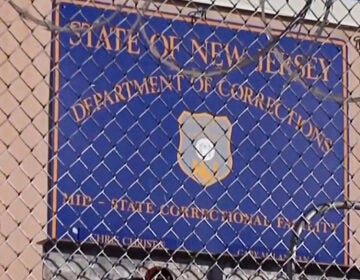Burlington County Prison Museum is restoring decades-old graffiti created by prisoners
The $2.9 million conservation project began in May and includes a new roof and other masonry work at the museum.
Listen 1:15
Meris Westberg of Jablonski Building Conservation works to preserve a calendar scratched by an inmate into a cell wall at the historic Burlington County Prison. (Emma Lee/WHYY)
From Camden and Cherry Hill to Trenton and the Jersey Shore, what about life in New Jersey do you want WHYY News to cover? Let us know.
Since May, the Burlington County Prison Museum in Mount Holly has been undergoing a $2.9 million restoration project, which includes preserving wall art created by prisoners who were housed there nearly seven decades ago.
The graffiti being conserved is from a ten-year period from when the prison walls were last painted in 1955, to when the prison closed in 1965.
Officials at the Burlington County Prison Museum Association said the drawings left behind by the prisoners are different from other jail art. The subject matter is not violent or pornographic, but more inspired by religion.

“There is quite a bit of religious graffiti in here,” said Stephanie M. Hoagland, principal and senior conservator with Jablonski Building Conservation Inc., a New York City-based architectural conservation firm that specializes in preservation of historic buildings, monuments, and other cultural resources. “There’s also a lot of calendars which are counting off the days until they get out and then there’s love notes.”
Jablonski is doing the preservation work under the oversight of New Jersey-based Netta Architects, the company that designed the building improvements.
Hoagland said prison graffiti is similar to military graffiti — it’s the expression of people who are “essentially trapped.”

The Burlington County Prison walls have depictions of God, and Bible verses including a commandment such as “Thou Shalt Not Steal” written in red letters.
“You have lots of time to reflect, you have lots of time to lament,” Hoagland said. “You have a lot of time to think about what you’ve done and how to make your life better.”

County Commissioner Allison Eckel compared the art work in the former county prison to the Lascaux Cave drawings in France.
“This is their expression of what they were going through at the time or how they needed to express what they’re going through in order to cope with their situation, and we feel like this is worth preserving,” Eckel said.
In addition to graffiti preservation, the prison is also getting a new roof and touch-ups on existing masonry work. The New Jersey Historic Trust has awarded the county a $526,500 grant to assist with the improvements.

Inaugurated in 1811, the Burlington County Prison was one of the first penal institutions in the United States. The building, located on High Street, was designed by Robert Mills, one of the first American-born professional architects, whose works include the Washington Monument, the U.S. Treasury Building in Washington, D.C., and the wings of Independence Hall.
The original prison held about 40 prisoners. At the time of its closure in 1965, it housed more than 100 people. In 1966, the prison re-opened as a museum. It was designated a National Historic Landmark in 1986.

Get daily updates from WHYY News!
WHYY is your source for fact-based, in-depth journalism and information. As a nonprofit organization, we rely on financial support from readers like you. Please give today.














